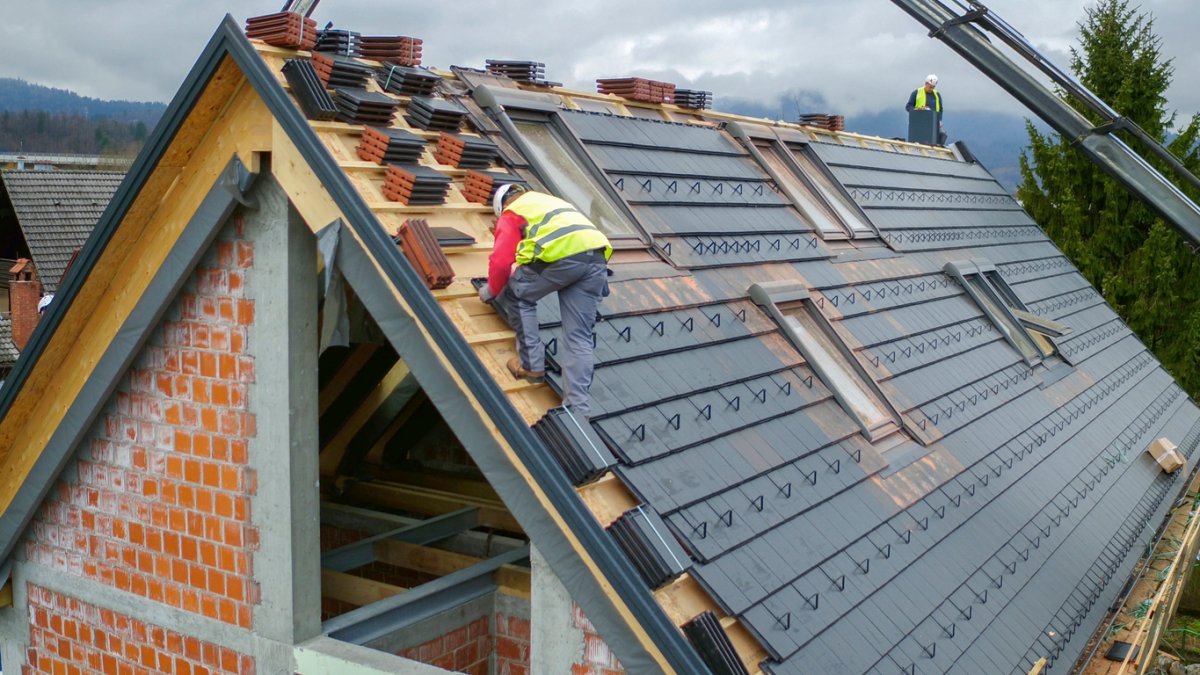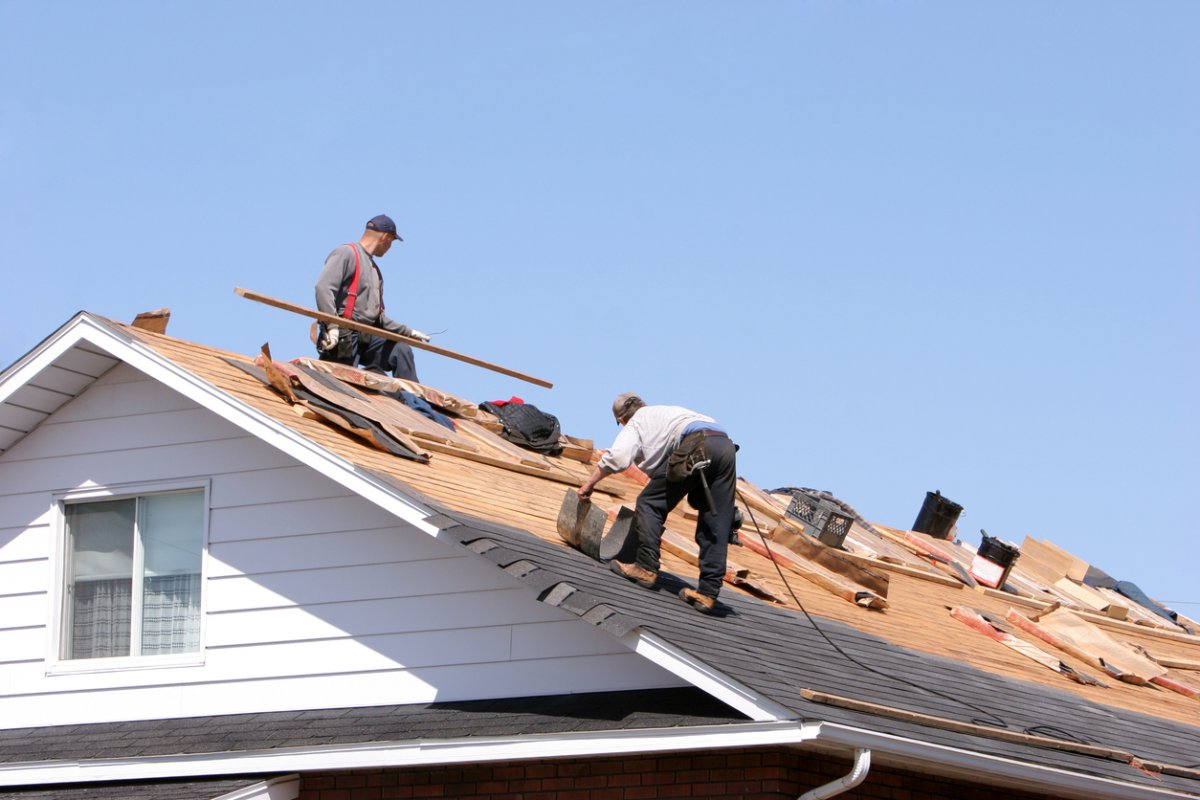We may earn revenue from the products available on this page and participate in affiliate programs. Learn More ›
For many homeowners, keeping a safe and secure roof over their family’s heads is a top priority. But when homeowners notice the signs they need a new roof, they may find themselves overwhelmed with the costs involved in residential roof replacement. Fortunately, there are several financing options available to make this essential home improvement project more manageable.
“Financing expands roof project options and allows homeowners to safeguard cash on hand for other purposes,” explains Mary Mokris, consumer finance and payments manager for GAF, one of North America’s largest roofing manufacturers. “Financing can also help increase home value by allowing homeowners to upgrade their roofing materials.”
Before starting a roof replacement project, homeowners will want to understand the factors that must be considered. They’ll also want to research the financing options that may be available to fund their project. This guide can be a good starting point to help homeowners learn about their options.
Before You Begin…
Before homeowners can secure roof financing, they must first consider several factors, including the scope of their project and the size of their budget. These factors will help homeowners determine whether they can afford to pay for the roof themselves or whether financing will be required.
“As with any major financial purchase, homeowners should consider their options carefully before getting a new roof,” says Mokris. “They should be aware of the age and condition of their current roof, the climate in their area, and their budget.” By assessing these factors ahead of time, homeowners can more easily determine the type of home improvement loan that is best suited for their needs.

Option #1: Check to see whether the roof replacement is covered by homeowners insurance.
Depending on the root cause of the roof damage, homeowners insurance may cover roof repair or replacement. However, Mokris explains that the scope of roof insurance will depend on the homeowner’s specific plan and provider.
“Homeowners insurance typically covers roof repairs or replacement if the damage is from a covered event, like a storm or fire,” she says. “Ultimately, it’s the specific policy they chose that determines the extent of the coverage. This is why it’s important that homeowners carefully review their policy to understand coverage limits, deductibles, and any exclusions.”
Because homeowners insurance has the potential to significantly reduce project costs, homeowners will want to explore this option before they consider other methods for financing a roof. However, it’s important to note that homeowners insurance will not cover roof damage caused by normal wear and tear. Instead, homeowners with this type of damage may want to investigate whether room damage is covered under a home warranty, if they have one.
Option #2: If the roof damage is minor and the roof doesn’t need to be fully replaced, a home warranty may be able to cover repairs.
Unlike homeowners insurance, a home warranty provides coverage on the home’s most critical systems and appliances, making it easier for homeowners to combat the normal wear and tear that can affect these systems over time. However, Mokris notes that every home warranty is not created equal, meaning homeowners will need to do some research to determine if this option is available to them.
“A home warranty may cover roof repairs, but similar to homeowners insurance, it depends on the policy,” she explains. “Home warranties in general have limited roof coverage and usually cover the basics, [such as] leaks or normal wear and tear.”
The best home warranties for roof coverage are likely to cover repairs to the existing roof rather than an entire roof replacement. For this reason, homeowners will need to compare their roof damage alongside the coverage available through their home warranty policy to determine if this option will meet their needs or if a new roof is required.
Option #3: Use your savings to pay for some or all of the roof replacement with cash.
If the cost of a new roof cannot be covered under their homeowners insurance or home warranty policy, homeowners will need to consider other alternatives. But before exploring the financing options on this list, homeowners will first want to consider tapping into their savings to cover some or all of their roof replacement costs. Paying in cash eliminates the need to take on additional debt, helping homeowners avoid potentially expensive interest costs. Plus, removing the need to obtain a loan to pay for the project can allow homeowners to replace their roof without delay.
If they cannot afford to cover the total cost of the project, homeowners can instead leverage their savings to reduce the amount they need to borrow from a lender. This can decrease the amount of interest paid over the life of the loan while also allowing homeowners to potentially secure more favorable loan terms. As such, covering some or all of the cost of a new roof with savings may be a worthwhile reason for homeowners to tap into their emergency funds.

Option #4: Consider paying for a new roof using a credit card with a 0 percent promotional rate.
If paying with savings is not a viable option, homeowners may want to consider a credit card over a loan for roof replacements. Credit cards offering 0 percent interest for a promotional period, often lasting 12 months, can give homeowners a way to spread out their roofing costs without paying hefty interest fees. In many cases, applicants must have a “very good” or “excellent” credit score to qualify for this type of offer, so it’s wise for them to check their credit report before deciding on this option.
Paying with a credit card may be a particularly appealing option for homeowners when the card comes with additional perks and incentives, such as cash-back rewards and bonuses. However, while paying with a no-interest credit card may be an option worth considering, it’s important for homeowners to understand that credit cards with high interest rates and limited rewards are best avoided, as interest charges can rack up quickly, outweighing any initial benefits. Therefore, if a low- or no-interest credit card is not an option, homeowners may be better off pursuing one of the other financing options on this list.
Option #5: Apply for a personal loan to cover the cost of a new roof.
New roof financing can also come in the form of a personal loan. Many of the best home improvement loans are personal loans, as these loans can be faster and easier to secure than other types of home improvement loans. However, it’s important for homeowners to note that rates and terms can vary significantly between lenders, so they’ll need to pay close attention to these factors before they commit to a loan.
Unlike many other financing options, personal loans are unsecured, meaning homeowners will not be required to use any form of collateral to secure financing. For some, this may be preferred, though it’s worth mentioning that unsecured loans typically come with higher interest rates due to the increased risk for the lender. Homeowners who are willing to use their home as collateral may be able to lock in a more favorable rate with a home equity loan or line of credit.
Option #6: Consider a home equity loan to pay for a new roof.
According to Mokris, one of the best ways for homeowners to pay for a new roof is by tapping into their home equity. Home equity refers to the amount of the home owned by the homeowner, built up over time through their monthly mortgage payments. Homeowners can easily determine the amount of home equity they have by subtracting their outstanding mortgage costs from their home’s total value.
“Home equity loans and home equity lines of credit (HELOCs) are great options for homeowners who have built up equity in their homes,” explains Mokris, noting that both options allow the lender to use the home as collateral, allowing homeowners to access more affordable rates. “Home equity loans have multiple benefits, including a fixed interest rate, set monthly payments, and longer loan terms.”
Homeowners who use one of the best home equity loans (such as a loan from U.S. Bank or Flagstar Bank) as a means of roof replacement financing will want to be aware that their home will be used as collateral. This means if they default on the loan, it could lead to the risk of a foreclosure. For this reason, it’s important for homeowners to consider how the monthly costs associated with a home equity loan might factor into their monthly budget.
Option #7: Look into a home equity line of credit (HELOC) as an alternative option.
Financing for a roof replacement could also come from a home equity line of credit. Much like home equity loan lenders, the best HELOC lenders (like Bank of America) allow homeowners to tap into their home equity to fund a large home improvement project, though these two financing options have a few key differences. While a home equity loan provides a lump sum of money, a HELOC functions more like a credit card, allowing homeowners to borrow money as needed throughout the draw period, which typically lasts around 10 years. When the draw period ends, the repayment period starts and homeowners begin to make payments on their loan.
“HELOCs provide flexibility in both the timing and the amount of money a homeowner can access,” explains Mokris. “HELOCs also usually start out with a lower interest rate than a home equity loan, though this interest rate is typically a variable rate, which means it will adjust with interest rate fluctuations.”
Due to their unique payment structure, HELOCs may be an appealing financing option, making it possible for homeowners to borrow only what they need for their roofing project. And as a bonus, they won’t need to worry about making payments on their borrowed funds in the short-term future. However, like a home equity loan, HELOCs use the home as collateral to secure the loan, so homeowners will want to make sure they can afford their payments before signing on the dotted line.

Option #8: Refinance your existing mortgage and get cash out of your home’s equity.
Homeowners can also choose to borrow against their home equity with a cash-out refinance through one of the best mortgage refinance companies (such as PNC or Caliber Home Loans). Unlike a home equity loan, which is considered a second mortgage and will require a second monthly payment, a cash-out refinance allows homeowners to replace their existing mortgage with a larger one, receiving the difference in cash. This cash can be used to cover the cost of an expensive home improvement project like a roof replacement. A cash-out refinance can be attractive when compared with other financing options because it often comes with lower interest rates than home equity loans or credit cards.
However, it’s important for homeowners to remember that refinancing the mortgage means extending the loan term, potentially adding years of additional mortgage payments. Refinancing will also impact the loan’s interest rate, which will adjust to match the market. Homeowners will need to carefully consider these factors and weigh them against the potential benefits before deciding to pursue a cash-out refinance. Otherwise, a poorly timed refi could lead to homeowners paying more than is necessary in interest over the lifetime of the loan.

Option #9: Ask the roofing company if it offers financing.
Some roof replacement companies may offer their own financing options, typically facilitated by a third-party vendor. Although these options can vary significantly between companies, homeowners who find a roofing contractor with financing may want to consider it, as contractor financing can be faster and easier to obtain than other forms of funding. The best roofing companies (such as Aspen Contracting or CMR Construction & Roofing) may be able to advise customers on the roof financing options available.
“Depending on [contractor] financing terms, homeowners can get the best possible roof for their needs, upgrade to a higher-grade shingle, and keep monthly payments at an affordable level,” says Mokris, noting that homeowners may be able to reap the reward of affordable interest rates, low monthly payments, and low- or no-interest promotional periods with contractor financing. Still, to get the best deal on their new roof, homeowners will need to compare multiple roofing companies, selecting the payment plan that best fits their needs.
Option #10: See if you qualify for a government-funded home improvement loan.
Government-backed loan programs are another option for roof replacement. The Federal Housing Administration (FHA) offers the 203(k) Rehabilitation Mortgage, which allows homeowners to combine repair, renovation, and mortgage costs into one convenient loan. For homeowners looking to purchase or refinance a home in need of repairs, this loan program can streamline the financing process, covering both the materials and the labor. Homeowners will want to look into how to get a home improvement loan through the FHA to see whether it’s a viable option.
These loans are backed by the federal government. They minimize the risk for the lender, and government-funded home improvement loans can be easier to obtain than other types of loans. However, in addition to the typical credit and debt requirements, homeowners will also need to meet certain income and property type requirements to qualify. Homeowners who refinance with an FHA 203(k) mortgage to pay for their new roof will also want to be aware that the covered work must begin within 30 days of closing and must be completed within 6 months.
“There is no one way that is better when financing a roof,” says Mokris. “It depends on each homeowner’s financial situation and their ability to afford the interest and principal payments of the financing method they choose.”
When comparing roofing financing options, homeowners will want to consider the pros and cons of each option as they relate to their unique needs, choosing the financing that best aligns with their budget and plan. To do this, homeowners will need to consider the scope of their project to understand the amount of funds they need and how urgently they need them.
“Homeowners who are interested in financing a new roof should plan about 2 months ahead,” advises Mokris. “Generally, getting a home equity line of credit and a home equity loan may take anywhere from 2 to 6 weeks. Because of this, they are great options for a planned roofing project, but not the best choice if major repairs are needed due to a leak or damage from a storm. Contractor financing can be a helpful resource when time is of the essence.”
Because roof replacement is such a big (and expensive) project, it’s important for homeowners to know their financing options ahead of time. Once they understand their options, homeowners can choose the one that will work best for their needs and budget.


